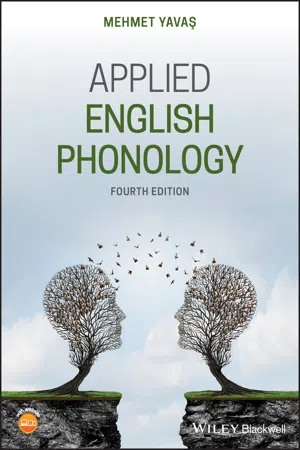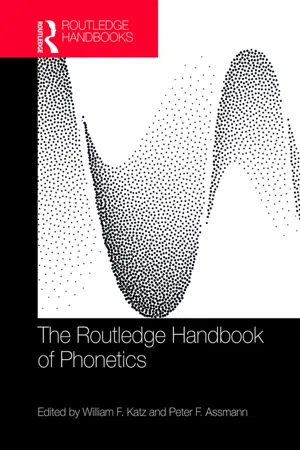Languages & Linguistics
Phonetics
Phonetics is the study of the physical sounds of human speech. It focuses on the production, transmission, and reception of these sounds, including their articulation and acoustic properties. Phonetics also examines how these sounds are used in different languages and dialects, and it plays a crucial role in understanding and analyzing speech patterns and communication.
Written by Perlego with AI-assistance
Related key terms
Related key terms
1 of 4
Related key terms
1 of 3
10 Key excerpts on "Phonetics"
- eBook - ePub
- Keith Allan, Keith Allan(Authors)
- 2015(Publication Date)
- Routledge(Publisher)
5 Phonetics The sounds humans make when speaking Andrew Butcher 5.1 Introduction Phonetics is traditionally defined as the scientific study of speech sounds, their articulation, transmission and reception. It deals with substance – with physical events which take place in time. Phonology, on the other hand, is the study of how speech sounds are used in language. It deals with form – with mental targets and symbolic representations. I use the term phonology in the same way as Hulst (see Chapter 6) uses the term ‘phonemics’. Unlike Hulst, I regard Phonetics and phonology as separate disciplines and thus I have no overarching term to encompass the two. But there can be no doubt that they are inextricably linked, and a central question for phonetic research (sometimes known as ‘the invariance question’) concerns the nature of the Phonetics/phonology interface: how are the discrete, static, context-free mental targets (phonemes) translated by the speaker into a continuous, dynamic, context-sensitive stream of sound and how does the listener retrieve those same mental targets from the continuous stream? Traditional descriptive Phonetics relies on the fact that human beings are capable of doing this, and that literate speakers of languages with alphabetic writing systems in particular become aware of phonemes at an early age. The objects of our description are thus chunks of the speech stream which we perceive as corresponding to phonemes. That this is not as straightforward as it seems becomes apparent if one attempts to discover such chunks in a language one does not speak. Phonetics is probably the oldest of the linguistic sciences, with a tradition that goes back at least to the India of the fifth century BCE and the work of Pāṇini on the sounds of Sanskrit. Interest in systems of notation continued in Europe in the eighteenth and nineteenth centuries, often with a prescriptive goal - eBook - ePub
Understanding English Language Teaching in EFL Context
From Idea to Practicality
- Kamal Ud Din(Author)
- 2023(Publication Date)
- Routledge India(Publisher)
Chapter 5 . English Phonetics and phonology is one such area in which several various approaches are adapted and adopted by teachers as per their needs and the needs of their learners. An exploration of various such methods related to the dimensions of English language teaching (ELT) can contribute positively to the overall effectiveness of ELT in context. Besides, in the English as a foreign language (EFL) context, Phonetics and phonology are much neglected areas; hence, conceptual understanding is at the initial stages. The present chapter adds the basic ideas with a view to balancing between the chapter being informative as well as pointing out some teaching strategies for Phonetics and phonology. The information on Phonetics and phonology and their teaching strategies is not new; however, the chapter would help English-language teachers to get some hints on how they can use the suggested strategies in their teaching practice. Hence, the expected objectives for the chapter reading would be as follows.Chapter Objectives:
- Readers should be able to;
- Develop an understanding and practice of English speech sounds and their production mechanism.
- Apply the knowledge of Phonetics and phonology in their ELT lessons to improve the four skills in the English language.
Ladfoged (2014 ) defined Phonetics as “The study of sounds and their physiological production and acoustic qualities” (Para-1). Kohler (2000 ) defined it as “the study of the spoken medium of language” (p. 1). Phonetics, in other words, is concerned with the mechanics of producing various sounds, which are used in human language. Phonetics is a vast science and thus has been categorized as a specialized field of knowledge within linguistics. In a general sense, Phonetics includes three major types found in the ELT literature: Articulatory Phonetics, acoustic Phonetics, and perceptual Phonetics. A brief definition of each will be presented here at the very beginning:- Articulatory Phonetics is the study of the way speech sounds are produced through the use of the mouth and peripheral organs.
- Acoustic Phonetics is the study of how speech sounds are studied concerning their qualities.
- Perceptual Phonetics is the study of how speech sounds are processed in the mind or perceived.
The study of Phonetics guides the learners on how to properly articulate individual sounds (phonemes). It enables the learner to produce a set of phonemes together (in form of words). It gives the base for setting standardized ways of producing language sounds. This not only helps in standardization but also helps in better communication in speech form. Sound pronunciation, correct spelling, and word recognition are the three key areas of language learning which can be taught and improved with the help of phonetic knowledge. - eBook - ePub
- Mehmet Yavas(Author)
- 2020(Publication Date)
- Wiley-Blackwell(Publisher)
1 Phonetics1.1 Introduction
Our aim in this book is to study the sound patterns of English. The understanding of phonological patterns cannot be done without the raw material: Phonetics. In order to be able to come up with reliable phonological descriptions, we need to have accurate phonetic data. Thus, students and professionals who deal with the patterns of spoken language in various groups of speakers (linguists, speech therapists, and language teachers) need a basic knowledge of Phonetics.Phonetics, which may be described as the study of the sounds of human language, can be approached from three different perspectives. Articulatory Phonetics deals with the physiological mechanisms of speech production. Acoustic Phonetics studies the physical properties of sound waves in the message. Auditory Phonetics is concerned with the perception of speech by the hearer. The coverage in this book will be limited to the first two of these approaches. The exclusion of auditory Phonetics is basically due to the practical concerns of the primary readership as well as the little information available about the workings of the brain and speech perception. In this chapter, we will look at the basics of speech production. Acoustic properties, in a limited form of spectrographic analysis and waveform analysis, will be the subject of Chapter 5 .1.2 Phonetic Transcription
Because we are constantly involved with reading and writing in our daily lives, we tend to be influenced by the orthography when making judgments about the sounds of words. After all, from kindergarten on, the written language has been an integral part of our lives. Thus, it is very common to think that the number of orthographic letters in a word is an accurate reflection of the number of sounds. Indeed, this is the case for many words. If we look at the words pan, form, print, and spirit, for example, we can see the match in the number of letters (graphemes) with the number of sounds: three, four, five, and six, respectively. However, this match in number of graphemes and sounds is violated in so many other words. For example, both should and choose have six graphemes but only three sounds. Awesome has seven graphemes and four sounds, while knowledge - eBook - ePub
- Ali Almanna, Juliane House(Authors)
- 2023(Publication Date)
- Routledge(Publisher)
Crystal 1980/2008 : 363).On this principle, Phonetics can be classified into three main branches:Why are there more sounds than letters in English?- ‘Articulatory Phonetics’ studies how the vocal organs (lips, tongue, teeth, etc.) are used to produce speech sounds.
- ‘Acoustic Phonetics’ investigates the physical properties of speech sounds in terms of duration, frequency, intensity, and quality.
What about the other languages that you are familiar with?- ‘Auditory Phonetics’ focuses on how people perceive speech sounds, i.e. how the listener’s eardrum is activated by the sound waves on the one hand, and how messages are carried to the brain in the form of nerve impulses on the other.
Discuss these points in other languages.- the same sound may be represented by many letters or combination of letters, for example the long vowel /iː/ is presented by the letters ‘e’, ‘ey’, and ‘ee’ in such words as ‘he’, ‘key’, and ‘see’;
- the same letter may refer to a variety of sounds, such as the letter ‘a’ in words like ‘cake’, ‘father’, and ‘village’;
- a combination of letters may stand for plenty of sounds, such as the letters ‘ch’ in words such as ‘character’ and ‘church’ or the letters ‘th’ in words like ‘either’ and ‘through’;
- a single letter may represent a great deal of sounds, such as the letter ‘c’ in such two words as ‘car’ and ‘receive’
- eBook - ePub
- Bruce M. Rowe, Diane P. Levine(Authors)
- 2022(Publication Date)
- Routledge(Publisher)
CHAPTER 3 Phonology: the sound patterns used in languagesDOI: 10.4324/9781003268369-3LEARNING OBJECTIVES- Explain the difference in the meanings of the terms Phonetics and phonology.
- Define the term phoneme. Define the term allophone.
- Analyze the statement: “Phonemes and allophones are considered mental constructs rather than being defined in terms of their specific physical properties.”
- Describe how a language’s phonemes are determined.
- Define the term distinctive feature. Explain how distinctive feature analysis helps us understand the systematic aspects of language.
- List the two major classes of phonological processes and explain how they differ from each other.
- Analyze the statement “Speech includes redundant features.”
- Discuss the meaning of the term markedness.
One lesson gained from Phonetics is that humans can produce a considerable variety of speech sounds. Yet each language limits the number of speech sounds that it uses. The sounds are organized into sound systems. Although the sound system of each language differs, some interesting general patterns are found in languages throughout the world. These sound system universals are discussed later in this chapter.Phonetics, the subject of Chapter 2 , deals with the nature of speech sounds. Phonology is concerned with the factors that make language a system; that is, with the systems used to organize speech sounds. We will begin this chapter with a look at the concept of the phoneme.Phonology is the study of the sound system of a language, that is, what sounds are in a language and what the rules are for combining those sounds into larger units. Phonology can also refer to the study of the sound systems of all languages, including universal rules of sound.The phoneme and the concept of significant differences in sounds
Any sound used in speech can be called a phone or phonetic unit or segment. A phone is a unit of sound that can be mentally distinguished from other sounds in what is actually the continuous flow of sound that makes up speech. A phone can be described based on its articulatory, auditory, and acoustic characteristics. For example, [ph - eBook - ePub
Speech to Print
Language Essentials for Teachers
- Louisa Cook Moats(Author)
- 2020(Publication Date)
- Brookes Publishing(Publisher)
2 Phonetics: The Sounds in Speech Chapter Goals •Define “phoneme” •Explain the differences between consonant and vowel phonemes •Explore and reproduce the English consonant phoneme and vowel phoneme charts •Pronounce all the consonant and vowel phonemes in isolation, using the consonant and vowel charts for reference •Reproduce the consonant and vowel charts from memory •Categorize consonants by specific distinctive features (e.g., nasal/oral; stop/continuant) •Categorize vowels by features of articulation (e.g., tense/lax, front/back) •Transcribe the phonemes in familiar words, using either the International Phonetic Alphabet (IPA) or a phonics symbol system •Translate words written in IPA or with phonics symbols into standard spelling •Identify spelling errors that reveal misperceptions of speech soundsWHY START WITH SPEECH SOUNDS?Phonetics is the study of the physical production and perception of speech sounds that occur in each language and in all languages. It is a topic within the broader topic of phonology, which is discussed in Chapter 3 . Speech sounds (phonemes) are the basic building blocks of words, the smallest units that make one word different from another. Perception of, memory for, and the ability to think about phonemes play a central role in learning to speak, read, and spell.Why should we focus on phonemes? First, phonemes determine the identity of words. The spoken words built, belt, and bolt all differ by one phoneme—the vowel sound—and mean different things. Conversely, we know that the vowels in those words are distinctive; their presence signals different words with different meanings. The spoken words sake, shake, and lake all differ by one phoneme—the initial consonant. Again, those consonants are phonemes because they distinguish word meanings. Photograph and phonograph, perfect and prefect, syllable and syllabus - eBook - ePub
- Kirsten Malmkjaer, Kirsten Malmkjaer(Authors)
- 2009(Publication Date)
- Routledge(Publisher)
The Handbook of Applied Linguistics, Oxford: Blackwell, pp. 187–209.Giles, H. and Robinson, W.P. (eds) (2001) The New Handbook of Language and Social Psychology, Chichester: Wiley, pp. 137–44.Auditory Phonetics
Definition
Auditory Phonetics is that branch of Phonetics concerned with the perception of speech sounds. It thus entails the study of the relationships between speech stimuli and a listener’s responses to such stimuli as mediated by mechanisms of the peripheral and central auditory systems, including certain cortical areas of the brain [see LANGUAGE PATHOLOGY AND NEURO LINGUISTICS]. It is distinct from articulatory Phonetics which involves the study of the ways in which speech sounds are produced by the vocal organs [see ARTICULATORY Phonetics], and from acoustic Phonetics which involves the analysis of the speech signal primarily by means of instrumentation [see ACOUSTIC Phonetics]. In fact, however, issues in auditory Phonetics are often explored with reference to articulatory and acoustic Phonetics, and there may be no clear distinction made by some speech-perception researchers between aspects of acoustic and auditory Phonetics due to the fact that the two fields are so closely related.Mechanisms involved in speech perception
Auditory perception of the sounds of speech requires that a listener receive, integrate and process highly complex acoustic stimuli which contain information ranging from relatively low to relatively high frequencies at varying intensities. Young adults can perceive sounds whose frequencies range from about 20 Hz (Hertz), i.e. twenty cycles per second, to about 20 kHz (kilo Hertz), i.e. 20,000 cycles per second. However, this entire range is not utilised in the production of natural speech sounds; hence the effective perceptual range is much smaller. Likewise, the dynamic range of the human auditory system is extremely large – about 150 dB (decibels). That is, if the smallest amount of intensity required to detect a sound were represented as a unit of 1, the largest amount tolerable before the ear sustained damage would be 1015. Needless to say, this full dynamic range is not utilised in normal speech perception. - eBook - ePub
Linguistics for Language Teachers
Lessons for Classroom Practice
- Sunny Park-Johnson, Sarah J. Shin(Authors)
- 2020(Publication Date)
- Routledge(Publisher)
2 PhoneticsThe Sounds of Language
2.1 Introduction
This chapter describes the physiological mechanisms of speech production and how we use articulators in the vocal tract to produce specific sounds. It will explain why a phonetic transcription is necessary to represent sounds in different languages and introduce the International Phonetic Alphabet. We will practice transcribing our own speech using these symbols and learn to group sounds into different classes based on their articulatory and acoustic properties. In addition, we will learn how a focus on prosodic properties (e.g., intonation, stress, and length), in addition to phonetic properties of individual sounds, can facilitate our teaching of pronunciation to second language learners.In this chapter, we begin with individual sounds, the smallest unit of language. We normally do not think about how sounds are produced in our native languages. The reason that language teachers learn Phonetics is to be sensitized to the properties of sounds in different languages—how they are produced (articulatory properties), and what they sound like (acoustic properties)—so that they can help their students to accurately distinguish and produce different sounds. In order to be effective in this endeavor, teachers will want to become familiar with the phonetic inventories of not only English but also the students’ native languages so they can identify potential areas of difficulty for the students.2.2 Why Do We Need a Phonetic Alphabet?
A good phonetic transcription system should have an unambiguous and consistent relationship between written symbols and the sounds that they represent. Each symbol should represent one sound only, and each sound should have only one symbol. The reason that we cannot use the English spelling system to describe sounds is that there is no one-to-one correspondence between English orthography and the sounds it represents. English spelling is highly irregular—the same letter can represent different sounds, or the same sound can be represented by different letters. For example, the letter s can represent a number of different sounds in English writing. It can represent the [s] sound in words such as s un, fas t, phonetics , the [z] sound in is, use, thieves or the [ʒ] sound in words like pleasure, leisure or no sound at all in aisle, island, debris. Conversely, the [i] sound in English can be written using different letters of the English alphabet, as in see , sea , icy , cei ling, sce nic, ravi ne, brief - eBook - ePub
- Hadumod Bussmann, Kerstin Kazzazi, Gregory Trauth, Kerstin Kazzazi, Gregory Trauth(Authors)
- 2006(Publication Date)
- Routledge(Publisher)
prosody, while in American linguistics phonology is occasionally used as an umbrella term for Phonetics and phonemics.(a) Structuralist phonology: structurally oriented phonology started with N.Trubetzkoy (⇒ Prague School) and quickly developed in several directions. While Trubetzkoy was concerned with the functional aspect of phonemic analysis, the principle of the opposition of phonemes as the basis of his phonological work, American structuralism bases its concept of phoneme largely on distributional criteria (see Bloomfield 1933; Harris 1951). Common to both varieties is the way in which phonology is understood as an autonomous level of linguistic description in contrast to generative phonology (see Chomsky & Halle 1968, among others). Phonology is considered a basic discipline of structuralist language analysis (⇒ operational procedure). This is particularly the case for the functional principle of distinctiveness (⇒ distinctive feature, opposition), the analytical process of segmentation and classification, but especially for the concept of the phoneme as a bundle of distinctive features and for the hypothesis of a universal inventory of phonological features as the basis for describing all languages of the world (see Jakobson & Halle 1956).(b) Generative phonology: in contrast to the structuralist interpretation of phonology as an autonomous level of linguistic description, in the framework of generative grammar, phonology refers to phonetic, phonological, and syntactic-morphological regularities (=systematic phonology). Instead of the phoneme, distinctive features of a universal character are considered the basic units of the phonological description (⇒ distinctive feature theory). On the basis of relatively abstract and stable underlying forms, the phonetic variants of the surface structure are derived from extrinsically ordered rules (cf. as the underlying form - eBook - ePub
- William F. Katz, Peter F. Assmann, William F. Katz, Peter F. Assmann(Authors)
- 2019(Publication Date)
- Routledge(Publisher)
Part IVLinguistic/perceptual Phonetics
Passage contains an image
13The interface between Phonetics and phonology
John KingstonIntroduction
An easy place to begin a discussion of the interface between Phonetics and phonology is with the speech chain, a phrase introduced by Denes and Pinson (1963) to describe the series of transformations a spoken message undergoes from its origin in the mind of the speaker to its destination in the mind of the listener. There appear to be at least two interfaces in this chain, the first between the phonological representation of the speaker’s intended message and its realization in their articulations, and the second between the auditory qualities evoked by the speech signal’s acoustics and the phonological representation that the listener recognizes. One might imagine that there are also two others, between the articulations and the acoustics of the speech signal and between the acoustics and the auditory qualities they evoke, but they are more properly transductions than interfaces because the natures of these transformations are entirely predictable from the physics, physiology, and psychology of the vocal and auditory apparatus. Figure 13.1 shows three representations of the most accessible link in this chain, the acoustic speech signal itself, its phonetic transcription (Figure 13.1a ), the waveform (Figure 13.1b ), and the spectrogram (Figure 13.1c ). The phonetic transcription includes some more detail than the phonological representation (Figure 13.1d), but clearly corresponds more closely to it than to either representation of the utterance’s acoustics (Figure 13.1b ,c
Index pages curate the most relevant extracts from our library of academic textbooks. They’ve been created using an in-house natural language model (NLM), each adding context and meaning to key research topics.
Explore more topic indexes
Explore more topic indexes
1 of 6
Explore more topic indexes
1 of 4









